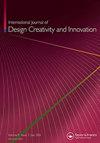Editorial
IF 2.5
Q4 ENGINEERING, MANUFACTURING
International Journal of Design Creativity and Innovation
Pub Date : 2018-04-03
DOI:10.1080/21650349.2017.1400152
引用次数: 0
Abstract
Creativity alone does not necessarily imply good Design, and apparently-well-designed products may not result in Innovation. This consideration alone constitutes a good reason for sharing a space to discuss how creativity, design and innovation interact. The International Journal of Design Creativity and Innovation (IJDCI) represents a unique scientific resource where such discussion can take place: after 5 years and 20 issues, IJDCI is entering its maturity stage being now indexed by two major scientific databases, thus increasing its visibility and offering to young researchers and expert scholars from different fields the opportunity to present their research outcomes and share new challenges they intend to face. Without any ambition to formally define ‘Innovation,’ a topic debated too much already, we would like to stress the importance of considering two essential dimensions of innovation: novelty and adoption. Clearly, any innovation requires some degree of novelty. However, there is no real innovation if that novelty is not adopted by some target community. Both dimensions offer many opportunities for studying the role that design creativity can play in promoting innovation. How to creatively explore new needs to satisfy? How to designerly identify new ways to face emerging social challenges? How to recognize and even anticipate value changes that could open innovation opportunities? These are just exemplary questions that might expand the discussion on design creativity when dealing with innovation and its multiple perspectives. At the same time, even more space for research emerges when referring to adoption issues. Can design creativity help identify new target communities at whom aim innovation? What actors have a stake in the adoption process? What factors affect the adoption process? It is important to notice that these issues do not necessarily refer to purchase decision mechanisms, but to any process that brings a certain community to accept a new solution in order to fulfill their expectations or to satisfy their exigencies. We hope these and more questions will be addressed by IJDCI authors with contributions capable of enriching the collective knowledge on design creativity and its role in the production of sustainable innovation of real value for society. This will require both qualitative and quantitative studies, characterized by scientific rigor and intellectual honesty. We certainly need models suitable for representing all stages, activities and objects of innovation processes, so as to increase our capacity to connect human needs and values with utility and functionality of artefacts and to elicit all related transformations. At the same time, we recognize the grounding value of the old quote ‘If You Can’t Measure It, You Can’t Improve It.’ Therefore, we welcome original contributions with proposals of comparison means to measure and analyse successful innovations and failures and the processes that characterize them from the perspective of all relevant actors. Both, models and quantitative comparison means, should foster the analysis of practitioners’ practices in order to identify regular patterns and conditions, and to test and validate new approaches, methods and tools that enhance design creativity. In fact, these represent a consolidated set of topics that has characterized IJDCI papers since its first volume. Overall, the International Journal of Design Creativity and Innovation confirms its vocation to be the melting pot of competencies from different domains such as systems engineering, information technology, computer science, artificial intelligence, cognitive science, psychology, philosophy, linguistics, management, and other related fields.社论
创造力本身并不一定意味着好的设计,很明显,设计好的产品可能不会带来创新。这个考虑本身就构成了一个很好的理由来分享一个空间来讨论创意、设计和创新是如何相互作用的。国际设计创意与创新杂志(IJDCI)代表了一个独特的科学资源,在这里可以进行这样的讨论:经过5年和20期,IJDCI正在进入成熟阶段,现在被两个主要的科学数据库索引,从而提高了它的知名度,并为来自不同领域的年轻研究人员和专家学者提供了展示他们的研究成果和分享他们打算面对的新挑战的机会。我们无意正式定义“创新”,这个话题已经争论得太多了,我们想强调考虑创新的两个基本维度的重要性:新颖性和采用性。显然,任何创新都需要某种程度的新奇。然而,如果某些目标群体不采用这种新奇的东西,就不存在真正的创新。这两个维度都为研究设计创意在促进创新中所扮演的角色提供了许多机会。如何创造性地探索新的需求来满足?如何以设计师的方式识别新方法来面对新出现的社会挑战?如何识别甚至预测可能带来创新机会的价值变化?这些只是典型的问题,在处理创新及其多角度时,可能会扩展对设计创造力的讨论。与此同时,当涉及到收养问题时,更多的研究空间出现了。设计创意能否帮助确定以创新为目标的新目标群体?哪些行为者在收养过程中有利害关系?哪些因素会影响收养过程?需要注意的是,这些问题不一定与购买决策机制有关,而是与使特定社区接受新解决方案以实现其期望或满足其紧急情况的任何过程有关。我们希望IJDCI的作者能够解决这些以及更多的问题,他们的贡献能够丰富关于设计创造力的集体知识,以及它在为社会创造真正价值的可持续创新生产中的作用。这将需要定性和定量研究,其特点是科学的严谨性和知识的诚实性。我们当然需要适合表示创新过程的所有阶段、活动和对象的模型,以便增加我们将人类需求和价值与人工制品的效用和功能联系起来的能力,并引出所有相关的转换。与此同时,我们认识到“如果你不能衡量它,你就不能改善它”这句老话的基础价值。“因此,我们欢迎提出比较方法的原创贡献,以衡量和分析成功的创新和失败,以及从所有相关参与者的角度描述它们的过程。”模型和定量比较手段都应促进对从业者实践的分析,以确定规律的模式和条件,并测试和验证增强设计创造力的新方法、方法和工具。事实上,这些代表了自第一卷以来IJDCI论文特征的主题的整合集。总体而言,《国际设计创意与创新杂志》确认了它的使命是成为来自不同领域的能力的大熔炉,如系统工程、信息技术、计算机科学、人工智能、认知科学、心理学、哲学、语言学、管理学和其他相关领域。
本文章由计算机程序翻译,如有差异,请以英文原文为准。
求助全文
约1分钟内获得全文
求助全文
来源期刊

International Journal of Design Creativity and Innovation
ENGINEERING, MANUFACTURING-
CiteScore
3.80
自引率
27.80%
发文量
15
期刊介绍:
The International Journal of Design Creativity and Innovation is an international publication that provides a forum for discussing the nature and potential of creativity and innovation in design from both theoretical and practical perspectives. Design creativity and innovation is truly an interdisciplinary academic research field that will interest and stimulate researchers of engineering design, industrial design, architecture, art, and similar areas. The journal aims to not only promote existing research disciplines but also pioneer a new one that lies in the intermediate area between the domains of systems engineering, information technology, computer science, social science, artificial intelligence, cognitive science, psychology, philosophy, linguistics, and related fields. The journal covers, but is not restricted to, the following topics: ·Theories on Design Creativity and Innovation ·Cognition of Design Creativity ·Innovative Process ·Inventive Process ·Analogical Reasoning for Design Creativity and Innovation ·Design Synthesis ·Method and Tools for Design Creativity and Innovation ·Representation of Design Creativity and Innovation ·Education for Design Creativity and Innovation ·Concept Generation and Inspiration.
 求助内容:
求助内容: 应助结果提醒方式:
应助结果提醒方式:


